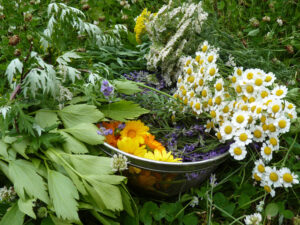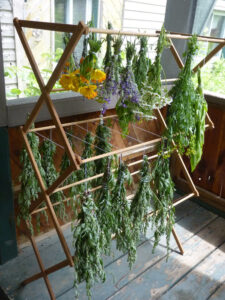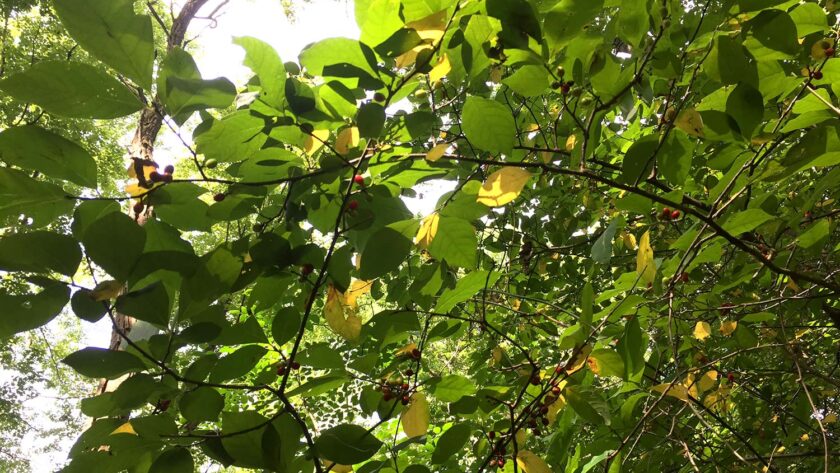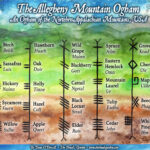Plants and mushrooms have been healing humans since long before recorded human history. Evidence of this abounds from healing plants and mushrooms found on preserved corpses and pre-historical burial grounds (such evidence of herbal use in Shanidar cave from 60,000 years ago and healing herbs and fungus found on Ötzi the Iceman & Princess Ukok,). And today, herbalists continue to practice these ancient healing arts, while modern medicine is increasingly providing more and more scientific evidence of the efficacy of traditional herbal remedies.

When someone takes up the practice of herbalism, herb gardening, and making medicine with plants, there is a natural connection that is forged with the essence of the plant–both the plant’s physical healing properties as well as the spirit of the plant. Healing happens in the body, mind, heart, and spirit, and plants can impact us on all those levels. Herbalists build deep relationships with plants, use their intuition to select herbs and heal on those multiple levels, considering the holistic approach to herbalism. On the nature spirituality side, your practice can be tremendously enriched by using plants to heal the mind, body, and spirit. Thus, herbalism and nature-based spirituality go hand in hand.
The Druids Garden Blog is almost 15 years old with 600+ posts–so I’m writing thematic guides to much of the content on the blog. In this guide to Herbalism, I first offer a roadmap of many of my herbal writings. I’ve been practicing herbalism, working with plant spirits, and making herbal medicines for 15 years, I write regularly for Plant Healer Magazine, and I teach herbalism in my local region. To me, herbalism is a wonderful opportunity to deepen our connection to the living earth, learn how to reciprocate and heal myself and others with the bounty of nature.
Herbalism 101: Getting Started & Cultivating Reciprocal Relationships with Plants and Nature
These writings set a foundation for any herbalism practice by articulating both introductory resources as well as establishing reciprocal relationships with the living earth. To me, the foundation of herbalism rests in three directions: understanding the human being and the body holistically; learning the plants, their actions, and temperaments; and learning how to interact in reverent, reciprocal ways with the healing plants to maximize their healing benefit.
A Beginners Guide to Learning Herbalism: This is an introductory guide for a variety of options to start learning herbalism–this walks through the different ways to learn, different aspects of herbalism (medicine making, materia medica, tools, body systems, nutrition, etc) and provides the beginner a great introduction!
An Exploration of Gratitude Practices and Plant Reverence in Herbal Practices: One of my writings for Plant Healer Quarterly where I provide a thorough introduction to developing gratitude and plant reverence practices, focused on the herbalist as a primary audience. To me this is a foundational practice of herbalism.
Ethical Sourcing of Medicinal Plants: The Case of American Ginseng: To practice earth-honoring herbalism is to ensure that you are sourcing plants ethically and continue to protect those who need it. This offers an overview of how to do so with an example of American Ginsengn and new regenerative farming approaches (a plant virtually eliminated in the wild my ecosystem).
Principles for Ethical Wild Food and Medicine Foraging: This post offers free resources to herbalists and teachers of wild food or wild medicine foraging. These are handouts and philosophies that I teach in all of my plant walks and herbal medicine-making courses.
Introduction to Foraging Part I and Part II: In this two-part series, I offer a range of considerations to wild medicine and wild food foraging foraging including ethics, safety, where and when to forage, how much to harvest, tools, avoiding pollution, and many other considerations.
Medicine Making: Processes and Recipes
Medicine-making is at the core of herbal practices. These posts offer information on how to harvest and prepare various herbal preparations: tinctures, teas, hydrosols, and double-extract tinctures, as well as a number of recipes for specific preparations: salves, elixirs, syrups, cordials, and drinks.
Medicinal Processes
Preserving and Preparing Plant Medicine: An introduction to how to make common herbal preparations including salves, tinctures, and teas (decoctions and infusions), as well as how to preserve and store plants in dried form.
Making Hydrosols without an Alembic: A great way to make hydrosols (floral waters) with simple tools you already have around your home and a bag of ice. This is an amazing and fun process, so I highly suggest you try it out.
Making Hydrosols and Essential Oils with an Alembic: If you get really into making hydrosols using the tools above, you might invest in an Alembic (still) that can produce much larger volumes of hydrosols. This post introduces what an Alembic is and how to use one!

Double-extract Reishi and other Mushroom Tinctures. If you want to extract the fullest medicinal benefit of a variety of medicinal mushrooms such as Reishi (Ganoderma Tsugae; Ganoderma Lucidum); Birch Polypore (Fomitopsis betulina); Turkey Tail (Trametes versicolor) and many others, you will want to learn how to create a double-extracted tincture. This extracts mushroom constituents in both water and alcohol, then combines them at a certain percentage for long-term preservation. This post offers step-by-step instructions, including mixing formulas.
Intuitive Herbal Sun Teas: How to create and blend lovely sun teas, particularly at the Summer Solstice and in the height of summer.
Creating a Homemade Tincture Press for $30 or Less: If you are going to create a lot of herbal medicine (especially tinctures) it can be very useful to have a tincture press. But if you look online, tincture presses are exorbitantly priced. This is a tincture press that I made almost 10 years ago for under $30 and it has worked wonderfully for many years!
Medicinal Recipes
Recipe: Elderberry Medicine: Elderflower Honey, Elderflower Cordial, and Elderflower-Lemon Tea. Make a range of lovely medicinal preparations from the Elder tree to support a healthy immune system, support a healthy fever response (by serving as a diaphoretic), and relax your body and mind.
Recipe: Elderberry Syrup with Ginger, Cinnamon, and Clove: A powerful healing immune-system tonic to strengthen your resilience and fight illnesses.
Recipe: Spruce or Pine Resin Salve: This is a messy salve to make, but it remains one of my very favorite salves, and is one I use all the time to heal my skin, protect chapped and damaged tissue, and promote healing.
Recipe: Four Sacred Trees Herbal and Magical Brew: One of my all-time favorite winter drinks; this brew uses hickory, maple, birch, and pine/eastern hemlock to combine in a very healing, delightful, and grounding beverage.
Jewelweed Infused Witch Hazel for Poison Ivy Dermatitis: This is a simple and very effective recipe for healing poison ivy with Jewelweed. Note that Poison Ivy remedies should never be oil-based.
Recipe: Backyard Healing Salve. This is my tried and true healing salve recipe, which I make every year and have taught to many people. This is the gateway salve for beginning to learn herbalism and how to heal with local plants. This salve is made with plants found in most lawns in many temperate places in Europe and North America (Plantain, Chickweed, Ground Ivy, Heal All, etc.).
Recipe: Dandelion Wine: My recipe is an award-winning, delightful, medicinal brew that soothes the mind, body, and spirit.
Materia Medica
Materia Medica refers to the collected wisdom or knowledge of how plants heal. These are the plant’s actions on the body’s systems as well as the plant’s affects on the mind, heart, and spirit. The earliest Materia Medicas were books full of healing properties and plant illustrations. Here I offer both some individual plant profiles as well as collections of healing wisdom.
Materia Medica Collections
Stinging Nettle (Urtica Dioica): Incredible medicinal ally and healing food. Support for asthma, allergies, kidneys and urinary system, anxiety, inflammation, and so much more.
Sweet Violet (Viola Odorata): A beautiful backyard healing and edible plant that is easy to find and easy to work with.
Wild strawberry (Fragaria Vesca): Another wonderful backyard healing plant!
Chickweed (Stellaria Media): A beautiful food-as-medicine and medicinal plant for healing from your backyard.
Please note that I also have extensive information on healing properties of trees in my Sacred Trees of the Americas series. You can see all of those articles here.
Materia Medica Collections
Mushrooms as Alchemists and Healers: A post introducing the many different kinds of healing that the fungi kingdom offers both humans and the planet.
Healing from the Hive: This post is from when I was still a beekeeper, and where I share a variety of herbal remedies that you can create from beehives.
Herbs to Support Creativity and Flow: My original research exploring herbs that are best to support creativity, tap into the Awen, and support the flow of creative ideas and practices in your life.
Herbs for Visionary Work: An introduction to non-entheogenic herbs for Visionary Work, with a complete listing of herbs that help cultivate inner vision, aid in relaxation, support memory, support lucid dreaming, and more. The post discusses both herbs to use and how to use them for visionary work.
Herbalism as a Spiritual Practice
In this collection of articles, I offer insights into deepening plant relationships, magical herbalism, rituals with plants, and plant spirit communication and journeying. This is where nature spirituality, druidry, and herbalism intersect.
Sacred Medicine Making at Lughnasadh: A description of my typical medicine-making practice for Lughnasadh, honoring plants and making tinctures and teas from the land.

Traditional Western Herbalism as a Sustainable Druidic Practice: Exploring the reciprocal nature of herbalism and nature-based spirituality through exploring similar foundations, approaches, and energies.
Herbal Grief Ritual for Healing the Soul: If you are grieving, this simple and beautiful ritual incorporating garden healing herbs will help you heal.
Working with Rosemary to Connect to the Ancestors at Samhain: Working closely with the prime memory and remembrance herb, Rosemary, to connect to ancestors and do deep work.
Wildcrafted Herbal Blessing Oil: An intuitive, beautiful oil that you can wildcraft to use for anointing and other blessings.
Plant Relationships, Cultural Appropriation, and Building Connections: An essay written as a guide to people who have inherited a legacy of colonialization and are trying to build a better way forward. This post offers suggestions for how to cultivate unique plant relationships.
Plant Spirit Communication Parts 1-4: Your Native Language, Many Ways Plants Communicate, Spirit Journeying with Plants and Medicine for the Body and Soul. Learning to communicate with plant spirits is a huge part of magical herbalism practice. This is my original series on Plant Spirit Communication; versions of this also appear in my book for the Plant Spirit Oracle and also my articles for Plant Healer Quarterly.
Building Sacred Plant Relationships at Lughnasadh: Insights and stories about building relationships with plants at Lughnasadh and building plant relationships over time.
Herbal Crafts
Beyond herbal preparation, I also share some plant-and-herb-focused crafts.
Herbal Smoke Clearing Sticks (Smudge Sticks): Step-by-Step Instructions & Recipes and Plant List. A complete guide to growing or foraging your own smoke-clearing sticks, which can be used both as a spiritual tool and as a medicinal smoke to benefit the mind, body, and spirit. The second post offers a comprehensive list of herbs and trees that grow in Eastern North America for you to use in your smoke-clearing sticks (that can be grown in a garden or wild foraged).
Creating Plant, Tree and Flower Essences. This post offers a thorough introduction to using and creating plant, tree, and flower essences for healing.
Wildcrafted Herbal Yule Decorations: Using the natural world and bringing the joy of the evergreens into your home during the winter solstice.
Tre Resins from North America for Incense Crafting: Smoke is one of the oldest forms of medicinal medicine. This offers my research into the many different tree resins that we can use for healing and incense crafting.
Herbal Philosophies
Philosophical articles and stories about herbs.
Embracing the First Responder Plants (Invasive, Opportunistic Plants): Many plants that are opportunistic (and may get an “invasive” label) are often first responders in a damaged ecosystem. I share a different perspective on these powerful plants in this article.
How Dana Cured her Asthma with Diet and Herbs: My story of how I took up the practice of herbal medicine and why it is so meaningful to me.
Weedtending, Weedwalking, Weedcrafting: An Herbalist’s Exploration of Weed Medicine and Healing: When plants are labeled “weeds” they are often considered nuisance plants. Here I offer an alternative perspective on weeds by sharing their medicinal and edible qualities.
Harvesting by the Sun, Moon, and Stars and with Sacred Intent: An introduction to how to harvest by the cycles of nature: by the sun, the moon, or astrologically so that you can create the most potent medicines possible.
My favorite Herbalism Resources
Here are some of the other places I recommend to learn more about herbalism!
Publications:
Plant Healer Quarterly and the Plant Healer Herbaria: This is a wonderful staple of herbalism and offers rich insights not only on the nature of plants and healing, but on a wide range of really fascinating areas that impact herbalism and practice.
Herbalists and Teachers
Jim McDonald, Michigan Folk Herbalist: Jim McDonald has been my primary teacher of herbalism, and his work has impacted and transformed the entire field of herbalism. Through his emphasis on teaching a system of traditional Western herbalism that emphasizes working with local herbs, building relationships with plants, and emphasizes holistic approaches. I truly cannot offer a higher recommendation than to Jim and his teachings. He has many free things on his site, online courses, and an in-person year-long herbal intensive. I graduated from the Lindera Four Seasons Herbal Course in 2014.
Herbs with Rosalee: I love Rosalee de la Floret’s approach to herbalism, both in her books and in her podcast. She is pragmatic and joyful in the way she approaches herbs–and writes some fantastic herbal recipes!
School for Evolutionary Herbalism: I’m a big fan of Saraj Popham’s work on vitalist herbalism, and I’ve subscribed to his monthly materia medica for a long time. This school is a great resource and focuses on vitalist or holistic herbalism, which integrates mind, body, and spirit.
Podcasts:
Plant Cunning – Issac Hill and A. C Stauble bring this incredibly good podcast exploring plants and plant wisdom.
Herbs with Rosalee – Rosalee de la Floret’s wonderful podcast about plants and plant wisdom.
Sources for Herbs and Herbal Remedies:
Sue’s Salves: My best friend Sue makes some of the best herbal medicine you can imagine :). Everything is lovingly grown in her garden, and because she is also a profesional astrologer, she harvests and prepares her medicines with the support of the stars.




this is an awesome entry point for your very large work!! thank you!
Hi Kaymarion, thank you so much! This process was super generative and also showed me what information I still need to write about. Glad it was useful to you! 🙂
What a treasure trove of knowledge!
Thank you for compiling your work for easy navigating!
Wish I would have found it when I was starting my studies lol, will definitely be sharing for those who are newer on the plant path!
Be well!
Hi Sabrena G, thanks so much! There’s definitely some 101 stuff here, but also some deeper stuff. Glad you found it helpful :).
Dear Dana, Thank you for sharing this, part of your life’s work and so much of your heart. As always I am very grateful for all of the wisdom you share! I am a part of the spiritual connection there is with Mother Earth and all of her creatures. I love that you speak to the spiritual healing qualities of the plants. This will keep me busy, and I’ll be joining AODA soon. Bright Blessings xo Diane
Hi Diane,
I’m so glad this list speaks to you! And delighted to hear you are thinking about joining AODA. Please let me know if you have any questions.
Blessings of the flowing maples,
Dana
This list is perfect for a late-winter immersion course into the herbs before they start peeking their heads out again. I’m looking forward to going through the posts as you listed here.
Hi Claudia, great! So glad it is useful to you. Blessings on your learning journey!